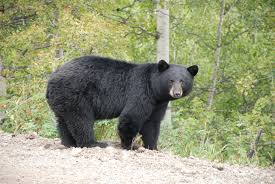DEC Gives Homeowners Guidance to Avoid Problems
with Bears and Conflicts with Coyotes
Greater chance for encounters with bears and coyotes as spring arrives in New York
The New York State Department of Environmental Conservation (DEC) today issued guidance on how to prevent negative encounters with black bears and conflicts with coyotes as warmer spring temperatures approach.
Bears
Nearly all negative bear encounters in New York are the result of hungry bears being attracted to human food sources. The simplest way to avoid a nuisance encounter is to remove potential food sources.
New York is home to more than 6,000 bears that emerge from the winter denning period and need to replenish nutrients and body fat. To do so, bears may travel long distances to preferred habitats that vary from season to season. Bears must sometimes cross roads or pass through developed areas to find these habitat, and often find human foods readily accessible if homeowners do not take necessary precautions.
Bears can obtain necessary food from the forest but are intelligent and opportunistic animals that find and consume easily accessible foods including, but not limited to, bird feeders, garbage cans, dumpsters, barbeque grills, unsecured out-buildings, or vehicles containing food or waste. Once a bear learns to obtain food from people or certain structures, it is difficult to change the animal’s behavior. These bears are more vulnerable to motor vehicle collisions in populated areas, more likely to be killed, or may become a threat to public safety.
In some cases, DEC is asked to relocate these bears. However, bear relocations are rarely effective and can be dangerous. Relocated bears often return to their original capture site, or may simply continue their bad habits at a new location. Additionally, if the circumstances that led to the original problem are not corrected, other bears may be attracted to the site and conflicts will persist.
It is dangerous and illegal to intentionally feed bears. The incidental, indirect feeding of black bears, such as with bird feeders or garbage is also unlawful.
To reduce the chance of negative black bear encounters, DEC recommends:
- Never feed bears. It is illegal, dangerous and detrimental to bears.
- If bears are being fed in your area, or you suspect a nuisance bear situation, report it to DEC immediately.
- Take down bird feeders after April 1. Birds do not need supplemental food in the spring and summer, when natural foods are most abundant.
- Clean barbeque grills before nightfall and don’t forget the grease trap. If possible, store grills inside when not in use.
- Store garbage in a secure building.
- In areas near bear habitat, put garbage containers by the curb just before the scheduled pick-up-never the night before.
- In densely populated bear areas, consider using a certified bear-resistant garbage container.
- Clean garbage cans frequently with ammonia products.
- Do not burn garbage. It is illegal and can attract bears.
- Do not add meat scraps, bones, or melon rinds to compost piles.
- Feed pets indoors and store pet food indoors. If pets must be fed outside, immediately remove all uneaten food and dishes.
- It is important to appreciate and respect black bears as wild animals, from a distance.
Coyotes
Coyotes are an integral part of New York’s natural ecosystem, but can also come into conflict with people if they become habituated to humans and food sources. With the onset of warmer weather, many of New York’s coyotes will set up dens for pups that will arrive this spring. Coyotes are well adapted to suburban and even urban environments, but for the most part will avoid contact with people.
The Eastern coyote is found everywhere from rural farmlands and forests to populated suburban and urban areas. In most cases, coyotes avoid people and provide many exciting opportunities for New Yorkers through observation, photography, hunting, and trapping. However, if coyotes learn to associate people with food, such as garbage or pet food, they may lose their natural fear of humans and the potential for close encounters or conflicts increases.
To minimize the chance of conflicts between people and coyotes, it is important to maintain coyotes’ natural fear of people. Below are recommended steps residents and visitors can take to reduce or prevent conflicts with coyotes:
- Do not feed coyotes and discourage others from doing so.
- Unintentional food sources attract coyotes and other wildlife and increase risks to people and pets. To reduce risks:
- Do not feed pets outside;
- Make garbage inaccessible to coyotes and other animals;
- Fence or enclose compost piles so they are not accessible to coyotes; and
- Eliminate availability of bird seed. Concentrations of birds and rodents that come to feeders can attract coyotes. If a coyote is seen near a birdfeeder, clean up waste seed and spillage to remove the attractant
- Do not allow coyotes to approach people or pets.
- Teach children to appreciate coyotes from a distance.
- If you see a coyote, be aggressive in your behavior. Stand tall and hold arms out to look large. If a coyote lingers for too long, make loud noises, wave your arms, or throw sticks and stones.
- Do not allow pets to run free. Supervise outdoor pets to keep them safe from coyotes and other wildlife, especially at sunset and at night. Small dogs and cats are especially vulnerable to coyotes.
- Fencing your yard may deter coyotes. The fence should be tight to the ground, preferably extending six inches below ground level, and taller than four feet.
- Remove brush and tall grass from around your home to reduce protective cover for coyotes. Coyotes are typically secretive and like areas where they can hide.
- Contact the local police department and DEC regional office for assistance if you notice that coyotes are exhibiting “bold” behaviors and have little or no fear of people. Seeing a coyote occasionally throughout the year is not evidence of bold behavior.
- Ask neighbors to follow these same steps.
If coyote behavior becomes threatening, report it to the local DEC office, as this may indicate that some individual coyotes have lost their fear of people and there may be a greater risk that a problem could occur. For additional information about the Eastern Coyote and preventing conflicts with coyotes, visit the Eastern Coyote web page and Coyote Conflicts web page on DEC’s website.
To learn more about New York’s black bears, visit DEC’s website or look for DEC’s DVD: ‘Living with New York Black Bears’, available at most local public libraries in New York.
For more information about bears in your area or to report a problem with black bears, contact the nearest regional DEC office. For listings of Regional DEC Offices, visit DEC’s website.


